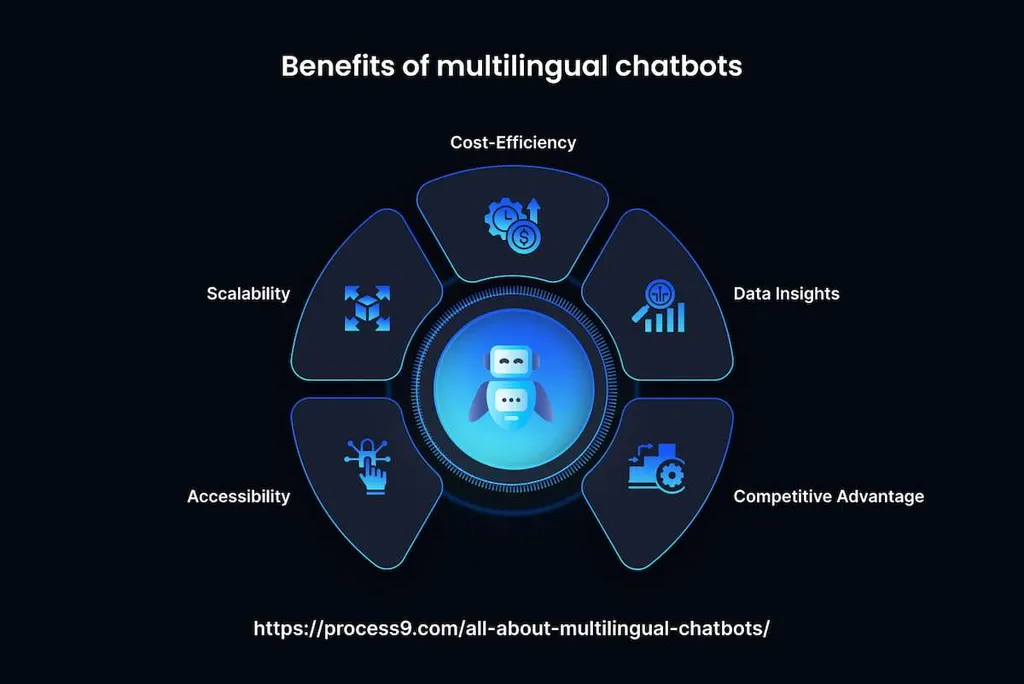When contacting a brand, clients expect to be served in their own language. A multilingual chatbot based on a powerful Large Language Model (LLM) allows them to receive a comprehensive reply relevant to their query without delays. Customer support teams benefit from deploying automated solutions. Virtual assistants allow them to reduce average response time, optimize workflows, and improve service quality. In this guide, we will explore the key upsides of deploying such solutions and analyze how companies can use them to boost profits.
What is a Multilingual Chatbot?

The term describes an algorithm-based tool designed to communicate with clients in different languages. These programmed tools utilize natural language processing and advanced translation capabilities to maintain engaging conversations. Such bots automatically recognize the language used by a user and respond in the customer’s native language. They have an advanced capacity to interpret text inputs with high accuracy. They detect subtle differences in meaning, pick up early signs of dissatisfaction, and analyze context to understand customers and supply them with the information they need.
It’s too expensive to hire a multilingual customer support team. AI chatbots facilitate reaching out to various audience segments across the globe and make a firm’s marketing efforts more targeted. People who order services online also want to communicate with a brand in their language. They want to receive regular updates about the status of their orders. The deployment of AI bots with multilingual conversational AI capabilities allows companies to save valuable resources, expand their outreach, and establish a foothold in foreign markets. Enterprises and organizations integrate AI chatbots with their systems to increase their efficiency.
Main Benefits of a Multilingual Chatbot

Businesses need to discover an efficient way to circumvent language barriers and reach out to various segments of their target audience if they want to get an edge over competitors. The deployment of AI bots trained on extensive datasets is the best solution to localization issues. Here are the key reasons that motivate enterprises to implement such tools:
- Automated support in multiple languages. Many firms receive numerous simple queries that can be solved with the help of algorithm-based assistants. AI tools are designed to instantly translate text in any language and provide quick replies. There is no need to bloat the staff to handle increased volumes of requests during peak times. Enterprises can invest in a multilingual chatbot to serve consumers in their regional languages and simplify understanding. It allows their CS teams to prioritize the most important tasks and serve customers better.
- Value for the money. It might require a significant initial investment to build an AI chatbot, develop a custom LLM, and create high-quality datasets. However, training a multilingual CS team can also be quite expensive. AI tools permit firms to scale their operations and achieve consistent growth. Automating most CS processes allows ventures to save funds and maintain high service quality. It enables enterprises to simplify understanding and build a loyal client base.
- 24/7 assistance. Most consumers expect to receive instant replies, regardless of the time zone. AI bots permit companies to serve customers outside regular business hours. These tools are ready to assist clients at any time.
- Global outreach. Quick assistance permits businesses to maintain a high level of engagement and connect with the target audience. People appreciate it when a brand provides post-purchase service. Multilingual chatbots increase conversions and enable firms to strengthen positions in foreign markets.
Besides, AI bots are fluent in multiple languages and provide assistance of consistent quality. While human agents might occasionally misinterpret some queries, AI tools have higher accuracy and improve performance over time.
How to Build a Multilingual Chatbot?
Digital assistants utilize neural machine translation (NMT) and ML technologies to detect the language of an incoming message based on contextual and other signs and use LLMs to generate text outputs and answer the query. They can differentiate between similar languages based on subtle cues and produce context-aware replies.
Thanks to the usage of ML algorithms, virtual assistants use feedback loops and learn from their interactions with clients. They discover the meaning of slang expressions, detect cultural nuances, and remember customer preferences.
Companies that do not have team members with extensive technical expertise in AI product development should follow such steps to build and deploy a powerful multilingual assistant:
- Register on a no-code platform that allows users to develop chatbots without writing code. These services require one to create an account and choose a suitable subscription plan to use them.
- Open a menu with chatbot building tools and create the conversational flow to define how the virtual assistants will communicate with clients. Many platforms allow users to paste prompts to create more efficient tools and specify in which cases queries will be transferred to human agents. Use the Add Language button to ensure your chatbot will provide multilingual assistance.
- Create a knowledge base. AI helpers require access to extensive datasets to provide detailed answers relevant to the questions. You can upload technical manuals and other documents to ensure your chatbot understands your company’s workflows.
- Test and launch your tool. If everything functions as expected, deploy the AI bot on your brand’s official website and across the main messaging channels used by your CS team.
You can choose any default language to enhance chatbot customer experience and then add the support of other languages preferred by your target audience segments. It will allow your team to provide personalized assistance to your clients.
Applications of Multilingual Chatbots
Companies were quick to recognize the advantages of AI technologies and deploy them to simplify their routines. They use bots to optimize operations and personalize communication with clients to make them feel heard and understood. Here are some of the areas where such chatbots have demonstrated high efficiency:
- Customer service. Clients no longer need to wait until their queries are answered. Digital helpers generate replies without delays and provide personalized assistance.
- Sales and marketing. Businesses can communicate with potential customers from different countries by launching efficient, culturally relevant campaigns in various languages. Chatbots allow buyers to reach out to brands directly and discuss their individual needs.
- eCommerce. Online stores deploy chatbots to simplify choosing and purchasing products. Such assistants streamline search, help customers navigate extensive catalogs, provide personalized recommendations, and offer other types of assistance. They integrate with extensive databases and can handle delivery updates, returns, warranty issues, and other problems a buyer may face.
- Healthcare. Providers serve patients better when they deploy multilingual chatbots. Such tools allow them to understand clients’ concerns, access patient records, speed up diagnosis, and make treatment programs more efficient. These assistants eliminate miscommunication issues and help patients achieve better health outcomes.
- Publishers. Companies with many subscribers often need to solve extensive volumes of repetitive queries that can be solved by AI chatbots. Algorithmic tools communicate with potential subscribers and convert leads effectively.
As technologies become more advanced, other use cases are expected to appear. AI tools allow companies of all sizes to make their services more accessible and provide timely assistance to different target groups.
Final Thoughts
A multilingual chatbot is a powerful solution designed for localized communication. However, developing such bots from scratch and building custom LLMs to power them might be too expensive for some businesses. This is why many companies outsource this task to reputable providers. MetaDialog builds enterprise-level LLMs designed to automate up to 81% of replies and increase a CS team’s productivity by 5 times. We develop powerful AI solutions to help firms scale and achieve sustainable progress. Get in touch with our team and discover how to implement chatbots to increase the effectiveness of your processes.
